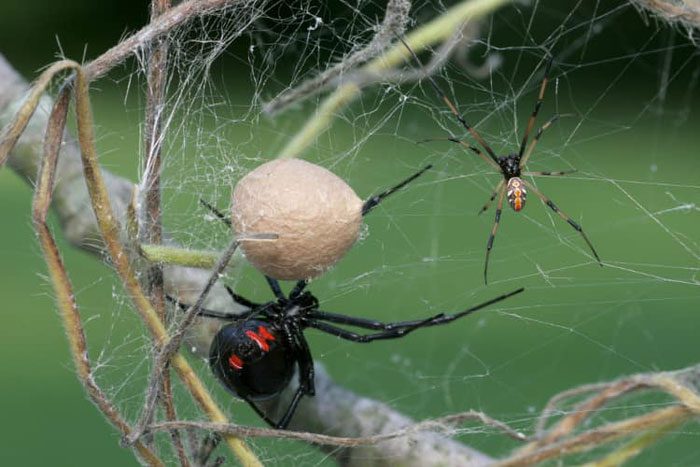The black widow spider (scientific name: Latrodectus mactans) can be found worldwide, with the highest populations in the southern United States and the western hemisphere.
The black widow spider is an extremely dangerous species, with venom that is 15 times more toxic than that of a rattlesnake. However, victims rarely face life-threatening situations. The most recent reported death due to a black widow spider bite occurred in 1983.
It is known that around 3% to 6% of the human population has an irrational fear of spiders in general. This fear is called “arachnophobia,” which causes significant anxiety and distress for those affected.
Most people believe that black widow spiders are aggressive and actively attack humans. In reality, they are quite reclusive and only bite when disturbed.

In this species, females are significantly larger and heavier than males, with females being 2-3 times the size of males, making it easy for them to kill the male after mating. The venom of the black widow is extraordinarily dangerous, being 15 times more potent than that of a rattlesnake. The neurotoxin known as latrotoxin from their bite is relatively strong, causing symptoms such as vomiting, difficulty breathing, delirium, partial paralysis, and even seizures.
The venom of this spider is quite potent and contains “latrotoxin,” a substance that affects the nervous system. In extreme cases, a black widow spider bite can lead to a condition called “latrodectism,” which causes severe pain, discomfort, and weakness in the body.
Depending on the amount of venom that has entered the body and the current health status of the victim, symptoms can vary. Common symptoms include swelling at the affected area, muscle stiffness, cramps, nausea, vomiting, abdominal pain, itching, rash, difficulty breathing, excessive sweating, and weakness.
Some victims of black widow spider bites will experience these symptoms immediately after being bitten, while others may begin to feel them within a few hours post-bite.

The most toxic of the latrotoxins is alpha-latrotoxin, which overwhelms the nervous system of the victims. If bitten by a black widow, alpha-latrotoxin will travel to the presynaptic regions of the nerve cells. This is where the synapses between a nerve cell and a muscle cell or another nerve cell meet, and it integrates into the membrane layer.
If unfortunately bitten by a black widow spider, there is no need to panic excessively. As mentioned, its bite can cause pain but is rarely fatal.
First, you should clean the affected area with soap and water. Keep an ice pack on the wound. This will slow the absorption of venom into the body. If possible, kill the spider and place it in a plastic bag or jar to show to a doctor for identification.
In most cases, victims of black widow spiders will recover within one week to ten days. Doctors typically prescribe pain relievers, anti-inflammatory medications, and muscle relaxants to the victims.
Victims with heart problems or other serious health issues may need to be hospitalized as a precaution. They will be monitored for immediate treatment in case complications develop.

Although extremely hazardous to humans, the bite of a black widow rarely results in death if the wound is treated promptly. Less than 1% of bitten individuals die. Nevertheless, never underestimate the dangers of encountering this species.
The black widow spider prefers dark areas and primarily operates at night. They are commonly found under logs, stones, leaves, stacks, debris, hollow tree stumps, caves, warehouses, garages, basements, attics, and other crevices.
Some female black widow spiders cannibalize males after mating, which is why this species has the term “widow” associated with its common name.
However, studies reveal that this is an exception, and not all female spiders exhibit this behavior. Evidence of cannibalism has been found in laboratories where males could not escape.
Additionally, male spiders often ensure their safety by sensing chemicals in the spider web, which helps them determine whether the female has already fed to avoid becoming her prey.
After mating, female spiders create parchment-like egg sacs containing approximately 250 to 700 eggs. While females mature in 90 days and live for about 6 months, males mature in 70 days and only live for about a month.

According to an article published in the Times of India, researchers at the University of Hamburg, Germany, found that male spiders sacrifice themselves for the health of their offspring. However, many disagree with this view, arguing it is simply due to the somewhat cruel behavior of the females.
Typically, the bite of a female spider causes more pain to the victim than that of a male. This is because females have larger venom glands, leading to much greater pain and discomfort for humans.
The two most common species of black widow spiders found in the United States are the northern black widow and the southern black widow. The northern black widow has a row of red spots on the top of its abdomen and two horizontal yellow or white stripes underneath. In contrast, the southern black widow has a round, glossy black abdomen with a red hourglass marking underneath.
The black widow spider has a series of short hairs at the end of its fourth pair of legs resembling comb teeth. For this reason, they are also known as “comb-legged” spiders.





















































